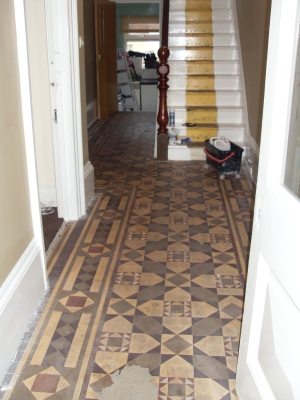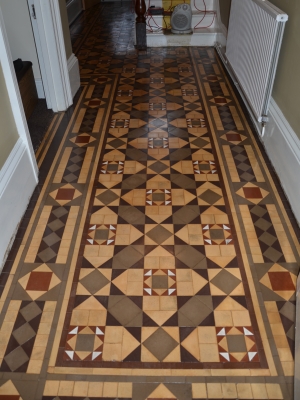email: enquiries@myfloorcare.co.uk
tel: 0191 209 3161
Floorcare Services
Cleaning
(no, I mean seriously... we can get the dirtiest tiles clean and new looking)
We have a selection of cleaning methods available to us. The cleaning method or process is dictated in the first instance by the stone type and then there are other determining variables like how heavily soiled is the floor, is there staining, are the tiles well fixed to the substrate, are there cracks, breakages, how sound is the grout... and several more.
Usually we will chemically cleanse and strip existing sealers, we will jet wash with specialist clean and capture equipment which has been designed with internal use in mind. The jet washing has two purposes, it pressure blasts the chemically softened dirt out of the pores and crevices in the stone, and it neutralises the tiles in preparation for the sealer applications when the tiles have dried.
Grinding
(marble, granite, travertine, limestone, terrazzo, concrete)
This removes all lippage from the tiles and makes the floor completely flat. A once in a lifetime job.
Grinding and polishing is never a job for an amateur. It is a highly skilled job requiring experience, patience and the correct equipment. It is pointless trying to grind a floor with a lightweight rotary scrubber machine or buffing machine... even with their so called lippage removal tools.
Proper grinding requires a heavy duty planetary head machine with can take lots of weight and has lots of power. Grinding is carried out wet, this helps the diamond heads cut it has the added bonus that there is no dust flying round. We will often start with a 50 grit diamond and end up using a 2000 grit if a real nice shine is required.
Concrete Polishing
If the concrete is good enough quality then we can grind and polish concrete to a high gloss finish.
The process is essentially the same as grinding and polishing say marble except that we use different types of diamond heads and we also add densifiers to the concrete at certain stages to harden it further. We can also stain and colour your concrete to create effects and patterns.
What about having your company reception area polished and your company name and logo stained into a highly polished concrete floor. Looks fantastic.
Stain Removal
As you would expect, if you've read this far, we have a selection of chemicals and processes for stain removal. The processes depend on the type of stone and the type of stain. If we know what caused the stain then we're most of the way there. Sometimes the application of the correct chemicals will lift a stain after a couple of applications. Sometimes however, stubborn stains will require poulticing.
As stated, the most important part is correct stone identification. If you put an acidic chemical onto a calcium carbonate stone (eg Marble, limestone, travertine) then you will only create more damage. We can repair the damage for you, but it's much better to get it right first time.
Email us photos of any damage along with as much info about the stain as possible, we'll be happy to tell you how to resolve the problem and we'll sell you the chemicals and powders to do it.
Stripping old sealers
This can be a DIY job, if you've got or can hire, a wet vac. You'll also need scrubbing brushes, rubber gloves, masks, waterproof trousers, masking tape for walls, skirtings and kitchen units protection. You'll also need masses of elbow grease. Lots of scrubbing, lots of rinsing and more scrubbing to remove the strippers. The residue created is particularly sticky and it tends to stick up the vacuum hoses and coats everything. It's not our favourite job.
Finally, it's important to determine which kind of sealers were on the floor in the first place. The sealers can be solvent, acrylic or water based and we use different strippers for each.
If you are buying your chemicals from us then we'll be happy to help you with instructions and tips.
Re-Sealing
A lot of our work is being called out to strip and re-seal newly tiled floors which have been incorrectly sealed in the first place!
The different sealers must be applied correctly. If it's just slapped on any old how then sealer marks will be visible for years. The floor will look like it has been mopped with an old mop and dirty water... and the marks don't go away! The only way is to strip the sealer.
Some beautiful shiny stones have been ruined in this way. BUT... there's always a positive... its usually possible to restore them.
We have found that some basalts have varying densities and so they absorb sealers at different rates, some of the sealers go deeper into the stone and stripping them completely is quite difficult if not impossible.
Always test sealers first on a spare tile or an out of the way spot.
Re-grouting
We have a selection of grout swatches from the major grout manufacturers and it is often impossible to guarantee an exact match (the human eye can discern over 10 million different colours. For example, if you have a newly painted wall painted with B&Q brilliant white emulsion, and I go in the middle of the wall and slap on a roller of brilliant white emulsion from Wickes... you'd spot it immediately and every time you walked in the room.
That being said, we're usually pretty close.
Making slip resistant
As above, we have a range of slip resisting techniques from lightly acid etching ceramic tiles through to flaming and staining granite tiles. Flaming is an expert technique, we use oxy acetylene flame played over the surface of the stone. The temperature of the flame is 3100 Degrees Centigrade (Is V Hot!) Some of the minerals in the stone have lower melting points than the others and they just jump out of the stone leaving a rough non slip surface.
You'll see flamed granite on old granite kerb stones in the older parts of your towns and villages.
Repairs
(Cracks, chips and holes)
Again, we have several techniques at our disposal. We use a selection of resins which we'll colour match to the stone we're repairing, we'll often take advantage of veins and minerals in the rock to help us disguise and break up cracks. We also use materials which are set within seconds by using ultra violet light. Similar to when the dentist sets a white filling with a ultra violet light probe. These are expensive, but they do a great job. We don't say that they're invisible. However if we are called out by a kitchen fitter because he has chipped a granite kitchen worktop, and the customer has not seen the chip or crack before we repair it, then they will never know that it has been repaired.
On the other hand, if a householder calls us out to repair a worktop or travertine shower tray or bowl etc, then they will always see it because they know exactly where to look, and as mentioned before, the human eye is pretty awesome. We always say that our repairs are always cheaper than the alternative, which is usually just ripping out and replacing. Of course, there is also the upheaval and inconvenience associated with the ripping out and replacing.
On a repair job we're quiet, no mess and in and out in an hour to two hours per repair.
Burnishing
We'll often burnish a floor when the customer does not want to go to the expense of grinding and polishing. We burnish using various powders and pads and sometimes diamond encrusted pads. The diamond encrusted pads will also remove smaller scratches from a softer floor like limestone, travertine and marble, which will in turn help restore a bit of the shine to the floor.
Honing
Honing a floor is a process of taking the shine back down a bit. A honed travertine tile for example is a tile which instead of being polished in the factory to a high gloss 200 grit+. It has just been taken to a 400 grit or 800 grit. This means the tile has quite a flat vapid or dull look to it. These are useful around swimming pools because they are less slippy, however householders often complain that they are hard to keep clean and they look dirty even after they've just been cleaned.
With some of the anti slip treatments available now, it is fine to have a high gloss tile in the bathroom, they look fantastic. Rubber bottomed bath mats are useful at shower and wet room step out points, and also at the side of the bath. They can be picked up and put on the towel rail after showering or bathing.
Crystalisation or vitrification
Some people also call this re-crystalisation.
It has benefits and disadvantages. Which I will mention after I briefly describe what it is.
Crystalising is a process where a chemical is buffed into the surface of the stone. The process changes the chemical composition of the top layer of the stone, depending on the type of chemical that is used.
We use a fourosilicate chemical and sometimes Oxcalic acid. These change the top surface of the stone from for example calcium carbonate (eg Travertine, marble and limestone) to calcium fluoride or calcium oxcalate respectively.
Changing the chemical composition of the top layer of the stone in this way has two main benefits.
- It becomes harder and more scratch resistant. This means the floor stays shinier for longer and looks good for longer.
- It takes a better and deeper shine. It looks really luxurious.
- It seals the stone so that sealer applications are not necessary.
Disadvantages:
There is only really one main disadvantage that I really mention to householders, and that is the fact that the stone becomes sealed at the surface. That means that the stone can no longer 'breathe'. If there is moisture underneath the stone then it can no longer work its way through the stone and evaporate at the surface. Sometimes, with excessive moisture underneath the stone, the hydrostatic pressure is such that it will burst its way through at the surface and fire off the weaker minerals in flakes and chips. This is called spalling.
I usually recommend not crystalising for 6 months to a year on new builds which have recent concrete slabs underneath.
Victorian tiles before and after restoration


